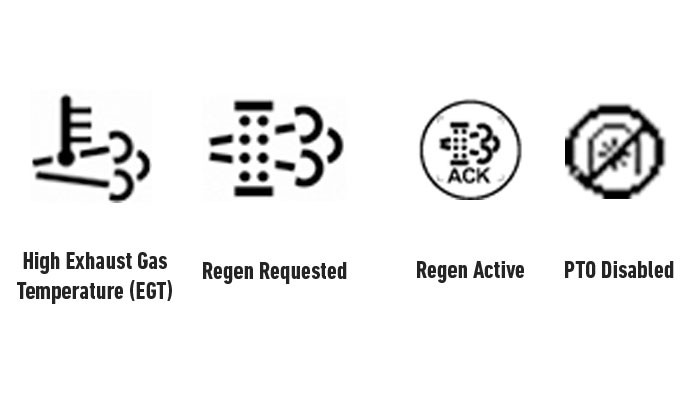Diesel Particulate Filters (DPFs) are essential components in modern diesel engines, playing a crucial role in reducing harmful emissions and meeting environmental regulations. A key aspect of DPF operation is managing Dpf Soot Load. This article, brought to you by the experts at obd-de.com, will delve into what soot load means, why it’s important, and how it relates to the regeneration process in your Toro® equipment and similar diesel machinery.
What is DPF Soot Load?
Soot load refers to the amount of particulate matter, or unburnt fuel, commonly known as soot, that has accumulated within the Diesel Particulate Filter. Think of the DPF as a filter in your exhaust system that traps these soot particles to prevent them from being released into the atmosphere. As your diesel engine operates, soot naturally builds up in the DPF. This accumulation is the dpf soot load.
Why is monitoring dpf soot load important? Because excessive soot buildup can lead to several issues:
- Reduced Engine Performance: A heavily loaded DPF can restrict exhaust flow, leading to decreased engine power and efficiency.
- Increased Fuel Consumption: The engine may have to work harder to expel exhaust gases through a clogged filter, resulting in higher fuel usage.
- Regeneration Requirements: When the dpf soot load reaches certain thresholds, the engine’s system initiates a regeneration process to burn off the accumulated soot. Understanding soot load helps predict and manage these regeneration cycles.
- Potential Damage: Ignoring high soot load warnings can lead to more severe problems, potentially damaging the DPF or other engine components.
The Regeneration Process and Soot Load Management
Regeneration is the process of removing the accumulated soot from the DPF by burning it at high temperatures. This process converts the soot into ash, significantly reducing the dpf soot load. There are different types of regeneration, each triggered based on the dpf soot load and engine operating conditions. Yanmar® engines, commonly found in Toro equipment, utilize several regeneration methods:
Automatic Regeneration Methods:
-
Passive Regeneration: This occurs automatically during normal engine operation when exhaust temperatures are naturally high enough to burn off soot. It’s the most seamless type of regeneration, and typically happens when the engine is under a good load, maintaining a lower dpf soot load level. No operator intervention or InfoCenter icons are usually involved in passive regeneration.
-
Assist Regeneration: When passive regeneration isn’t sufficient to manage the dpf soot load, assist regeneration kicks in. The engine’s throttle valve is used to reduce fresh air intake, increasing exhaust gas temperature and promoting soot combustion. During assist regeneration, an icon will appear on your Toro InfoCenter, indicating the process is active, but normal machine operation can continue.
-
Reset Regeneration: For higher dpf soot load levels, reset regeneration employs both intake throttle adjustments and post-fuel injection to further elevate exhaust temperatures. The InfoCenter will display the High Exhaust Gas Temperature (EGT) icon during this process. Again, machine operation can continue, although running the engine at full throttle is often recommended to aid soot removal.
Manual Regeneration Methods:
-
Parked/Stationary Regeneration: If automatic regenerations are unable to adequately reduce the dpf soot load, a Parked regeneration becomes necessary. This is a manual process initiated by the operator through the InfoCenter’s Service menu. The machine must be stationary during this approximately 30-minute cycle. The system will prompt for a Parked regeneration with InfoCenter advisories, and ignoring these warnings can lead to performance degradation and eventually PTO (Power Take-Off) disablement in equipped units.
-
Recovery Regeneration: Recovery regeneration is the most intensive DPF cleaning method, used when dpf soot load is critically high. Like Parked regeneration, it requires the machine to be stationary and is initiated manually via the InfoCenter. This process can last up to 90 minutes, and the PTO will be disabled during recovery regeneration. The InfoCenter will alert the operator when a Recovery regeneration is needed.
Understanding these different regeneration types highlights how the engine management system actively works to control dpf soot load and maintain optimal emissions performance.
InfoCenter Symbols and Soot Load Monitoring
Your Toro InfoCenter provides visual cues about the regeneration status and dpf soot load levels:
 Toro InfoCenter display showing icons for High Exhaust Gas Temperature, Regeneration Requested, Regeneration Active, and PTO Disabled related to DPF regeneration.
Toro InfoCenter display showing icons for High Exhaust Gas Temperature, Regeneration Requested, Regeneration Active, and PTO Disabled related to DPF regeneration.
-
High Exhaust Gas Temperature (EGT) Icon: Indicates Assist or Reset regeneration is in progress. Exhaust temperatures are elevated to burn off soot and reduce dpf soot load. No operator action is typically needed.
-
Regen Requested Icon: Signals that a Parked/Stationary or Recovery regeneration is required due to high dpf soot load. The operator should initiate the appropriate manual regeneration process as prompted by the InfoCenter.
-
Regen Active Icon: Displayed when a Parked or Recovery regeneration cycle is currently running, actively reducing dpf soot load.
-
PTO Disabled Icon: Indicates the PTO has been automatically disabled due to a severely high dpf soot load and the need for Recovery regeneration.
Accessing Soot Load Information in the InfoCenter
For detailed information about your engine’s regeneration system and dpf soot load, navigate to the SERVICE menu in your InfoCenter. Key options include:
-
Soot Load: This displays the current dpf soot load as a percentage reported by the engine. Understanding these percentages is crucial:
- Above 78% Soot Load: Reset regeneration is activated.
- At 100% Soot Load: Parked regeneration is requested.
- At 122% Soot Load: Recovery regeneration is requested.
- Note that the soot load can range from 0% to 250%, and fluctuations are normal.
-
Time Since Regen: Shows the time elapsed since the last successful Reset, Parked, or Recovery regeneration cycle. This helps track regeneration frequency and potentially identify issues if regenerations are happening too often.
By regularly checking the InfoCenter, operators can proactively monitor dpf soot load and respond to regeneration requests promptly, preventing performance issues and downtime.
Maintaining Optimal DPF Performance and Managing Soot Load
Proper maintenance practices are essential for keeping your DPF system healthy and effectively managing dpf soot load:
-
Use the Correct Diesel Fuel: Always use ultra-low sulfur diesel fuel (ULSD) with less than 15 parts per million (ppm) sulfur content. Higher sulfur content can damage the Diesel Oxidation Catalyst (DOC) and negatively impact DPF function, leading to increased dpf soot load and regeneration issues.
-
Use CJ-4 or Higher Engine Oil: Tier 4 diesel engines require CJ-4 specification (or higher) low-ash engine oil. Using incorrect oil can cause premature clogging of the DPF with ash, increasing dpf soot load and reducing engine performance.
-
Address Regeneration Requests Promptly: Do not ignore InfoCenter warnings about regeneration. Delaying Parked or Recovery regenerations can lead to further soot buildup and potential engine problems.
By understanding dpf soot load, the regeneration process, and utilizing the information provided by your Toro InfoCenter, you can ensure the efficient operation and longevity of your diesel engine and its emissions control system. For further details on Tier 4 technology and regeneration, consult your Toro equipment manuals and resources.
